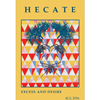AustLit
-
The journal takes its name from the ancient Greek goddess Hecate, a symbol of female strength and power in Greek mythology. Ferrier first envisaged her work to be titled Cauldron, as fate would have it, women at the University of Sydney were developing an Art journal of the same name. Unfased, Ferrier surrendered the name. In search of another, she reflected on the subversive origins of witches, magic, and cauldrons, and came upon the ancient Greek goddess.
Thus, the interdisciplinary journal titled Hecate was born. The first issue used William Blake’s The Night as the front-cover picture. To encapsulate the exact meaning and symbolism of the Greek Goddess, the earliest editions of Hecate printed a summary on the back cover written by Janet D’Urso:
The Great Goddess Hecate is anathema to those who worship Western father gods, governing as she does the aspects of strong women who demand the exercise of choice and individuality. Hesiod, no admirer of women, wrote that she was ‘almost the chief of all the gods’; typically, this statement has been either dismissed, misunderstood or regarded as an unfortunate error by male classicists. If anything, Hesiod was too cautious.
The goddess Hecate is the ruler of life and death, the controller of fertility and infertility, the kindly assistant of women in childbirth or the compassionate goddess who relieved the burden of unwanted pregnancies. In women's eyes, Hecate holds positive intent, though to men she can be destructive. Hecate is the Goddess invoked by women who desired freedom from male tyranny.
The goddess Hecate is presented as a resistor of the male and patriarchal. Historically, she is a precursor to father gods affiliated with Judeo-Christian faiths and can be regarded as the original Matriarch. Within mythology, Hecate is deemed too fearful (to men) to be provided with a husband, and thus represents female sovereignty and freedom. Moreover, Hecate shares gifts of magic, inspiration and understanding and governs the creative, unconscious mind; she offered women the power of awakening or dampening male desire and can curse conquerors or unjust rulers. Likewise, she represents the cycle of the seasons; a triple goddess who is Everywoman.
Hecate proposes that the naming of the journal after this Greek goddess is a symbolic gesture to all that is “proud, untameable, autonomous, compassionate, angry, strong, creative, intelligent and brave” in women. Hecate provides a platform that gives a voice to all women who were or are repressed or denied, yet who know how to: “push towards the light like shooting blades of barley.”
The last 44 years of Hecate have demonstrated how the journal's values, writing, and influence reflect the goddess Hecate and her representation of every woman. Hecate is a synergised component of the journal's identity, inscribing all that is woman.
You might be interested in...






